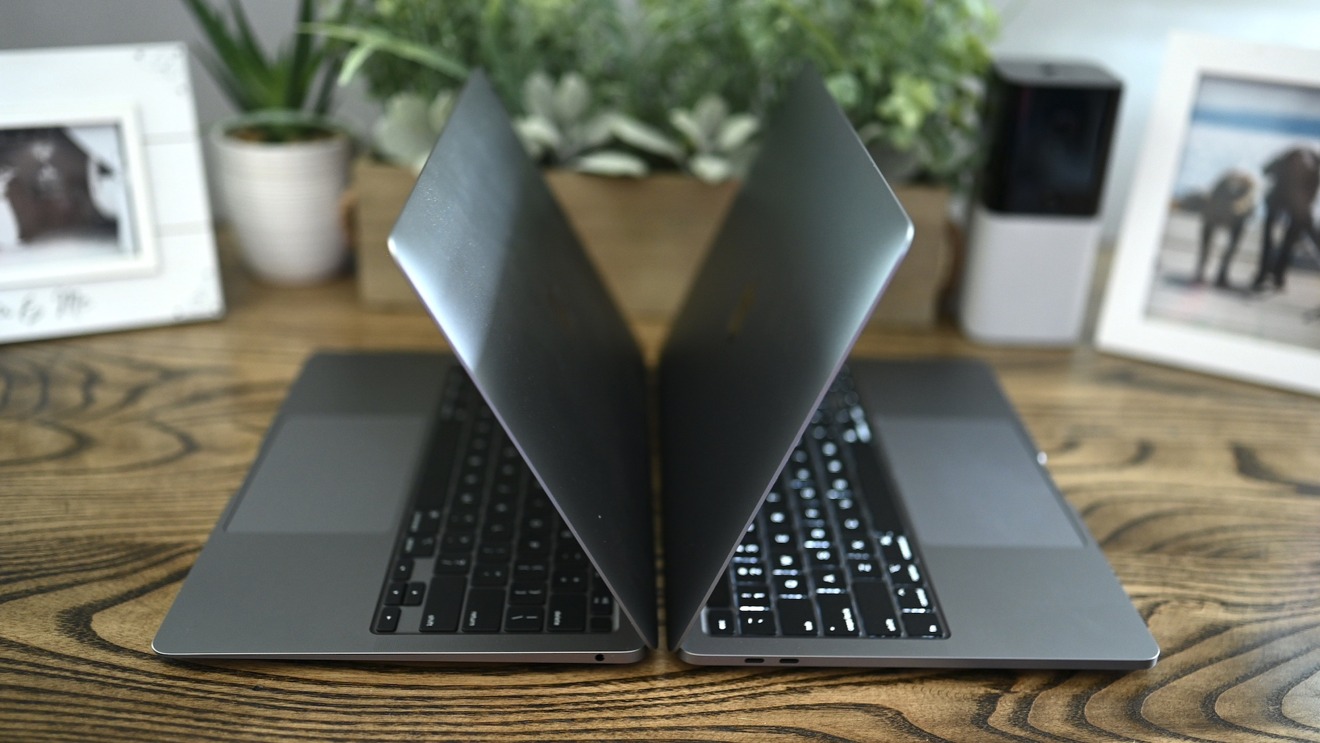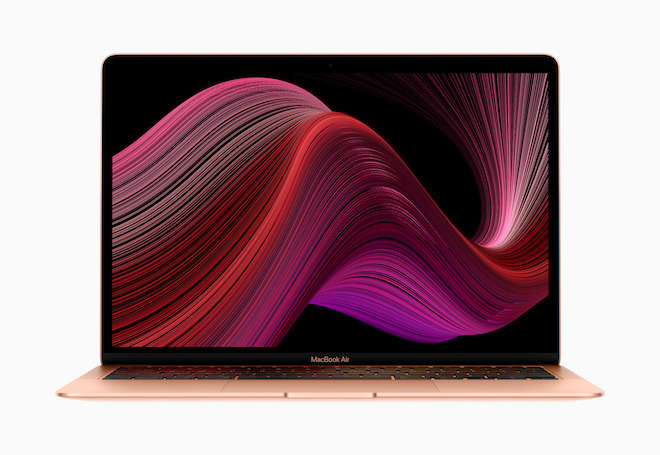Before Monday's 13-inch MacBook Pro update, the choice between the 2019 model and the 2020 MacBook Air was very clear. It is less clear today — but we can help.
On Monday, Apple refreshed the 13-inch MacBook Pro. While it wasn't the 14-inch revamp some were expecting, the new models still pack a solid update on the popular and smaller-bodied MacBook Pro.
The new 13-inch MacBook Pro has made Apple notebook buying decisions a bit more complicated. With that in mind, here's how the new 13-inch MacBook Pro models stack up against the existing MacBook Air — and which model you should buy for your own needs.
2020 13-inch MacBook Pro versus 2020 MacBook Air - specifications
| MacBook Air (2020) | 13-inch MacBook Pro (2020), Two Thunderbolt Ports | 13-inch MacBook Pro (2020), Four Thunderbolt Ports | |
|---|---|---|---|
| Price | $999 Lowest MacBook Air prices | $1,299 Lowest 13" MacBook Pro prices | $1,799 Best deals on 10th Gen models |
| Dimensions (inches) | 0.16-0.64 x 11.97 x 8.36 | 0.61 x 11.97 x 8.36 | 0.61 x 11.97 x 8.36 |
| Weight (pounds) | 2.8 | 3.1 | 3.1 |
| Processor | 10th-Gen 1.1GHz dual-core Intel Core i3 10th-Gen 1.1GHz quad-core Intel Core i5 | 8th-generation 1.4GHz quad-core Intel Core i5 8th-generation 1.7GHz quad-core Intel Core i7 | 10th-generation 2.0GHz quad-core Intel Core i5 10th-generation 2.3GHz quad-core Intel Core i7 |
| Graphics | Intel Iris Plus Graphics | Intel Iris Plus Graphics 645 | Intel Iris Plus Graphics |
| RAM | 8GB or 16GB | 8GB or 16GB | 16GB or 32GB |
| Networking | 802.11ac Wi-F Bluetooth 5.0 | 802.11ac Wi-Fi Bluetooth 5.0 | 802.11ac Wi-Fi Bluetooth 5.0 |
| Storage | 256GB, 512GB, 1TB or 2TB SSD | 512GB, 1TB or 2TB | 512GB, 1TB, 2TB or 4TB |
| Display type | 13.3-inch LCD with IPS 400 nits brightness Full standard color | 13.3-inch LCD with IPS 500 nits brightness Wide Color (P3) | 13.3-inch LCD with IPS 500 nits brightness Wide Color (P3) |
| Ports | Two Thunderbolt 3 ports 3.5mm headphone jack | Two Thunderbolt 3 ports 3.5mm headphone jack | Four Thunderbolt 3 ports 3.5mm headphone jack |
| Biometrics | Touch ID | Touch ID | Touch ID |
| Touch Bar | No | Yes | Yes |
| Battery Size | Up to 11 hours of web browsing | Up to 10 hours of web browsing | Up to 10 hours of web browsing |
| Colors | Space Gray, Gold, Silver | Space Gray, Silver | Space Gray, Silver |
Performance
The 13-inch MacBook Pro sits right between the consumer-aimed MacBook Air and the beefy 16-inch MacBook Pro. While Apple's 2020 13-inch models can be configured with 10th-generation Intel chips, only the higher-end variants get them.
Apple's MacBook Pro models with two Thunderbolt 3 ports, which start at $1,299, are still equipped with older 8th-generation Intel Core processors and embedded Intel Iris Plus 645 Graphics.
With the company's 2020 MacBook Air refresh, Apple's most affordable $999 notebook is much more similarly matched with the Pro models. The notebook now packs updated Intel Iris Plus Graphics and can be upgraded to a quad-core, 10th-generation Intel Core processors.
Keep in mind, however, that the MacBook Air has lower-wattage Y-series chips, which are optimized for productivity tasks and energy efficiency. The low-end MacBook Pros are equipped with faster U-series Intel processors.
In performance testing, the low-end entry-level dual-core i3 MacBook Air earned a 1074 and a 2412 in Geekbench 5.1.1 single and multi-core tests. The spec'd out quad-core 1.2Ghz i7 earned a 1294 and a 3514 respectively.
The new 2020 MacBook Pro starts out with a 1.4Ghz quad-core i5 processor and earns a 948 and a 4015 on the same benchmarks. It outperforms the entry-level by a large margin due to being a quad-core machine rather than a dual-core, but even the max i7 model of the Air can't match the multi-core performance of the 2020 13-inch Pro.
The MacBook Pro only goes up from there in terms of performance, especially with the 10th-gen chips on the upper-end units.
If you care only about performance, the MacBook Pro is absolutely the way to go. You have to upgrade to the $1,449 machine to get even similar performance to the $1,299 MacBook Pro.
Apple's Butterfly keyboard versus the Magic Keyboard
The 2020 13-inch MacBook Pro refresh has completed Apple's transition over to the Magic Keyboard from the much-maligned butterfly keyboard. The company now no longer sells a MacBook with the butterfly switch.
That means you'll see longer key travel and likely fewer instances of keyboard malfunction as compared to the 2018 and earlier revisions. Apple's new Magic Keyboards are also quieter than the clicky butterfly keyboard, especially the earlier models.
The Magic Keyboards on the MacBook Air and the new MacBook Pros are going to be similar, if not identical. Like the 16-inch model, the new 13-inch MacBook Pros also feature a dedicated Escape key, a discrete Touch ID sensor and inverted-T arrow keys.
Really the only significant difference between the Air and the Pro in this area is the OLED Touch Bar. The MacBook Air still has physical Function keys, while all MacBook Pro models come with the Touch Bar.
Display, ports and battery life
The 13-inch MacBook Pro and the MacBook Air both have essentially the same display, which measures 13.3 inches on the diagonal and comes with IPS technology. Even the resolution is the same, though the MacBook Pro models sport Wide Color (P3) support and are slightly brighter.
The port situation differs depending on the configuration. The MacBook Airs are only ever going to come with two ports, just like the lower-end 13-inch MacBook Pros. The higher-end 13-inch MacBook Pro, which starts at $1,799, has four Thunderbolt 3 ports.
When it comes to power, the MacBook Air has a smaller battery but longer battery life thanks to its energy-efficient processor. It's rated for up to 11 hours of wireless web browsing or up to 12 hours of Apple TV app movie playback, according to Apple.
The 13-inch MacBook Pro models are rated for up to 10 hours of wireless web browsing and 10 hours of Apple TV app movie playback. The Pros also come with a larger power adapter — 61-watt versus the MacBook Air's 30-watts.
Configurations
Apple has added more options configuration options to the 13-inch MacBook Pro, including variants that support up to 32GB of RAM and 4TB of SSD storage.
At the base level, the two-port 13-inch MacBook Pro is equipped with a 256GB SSD and 8GB of RAM. That's exactly the same as the base model MacBook Air, which is around $300 cheaper.
Something else to keep in mind is that the base model 13-inch MacBook Pro, which starts at $1,299, is equipped with slower LPDDR3 memory. The MacBook Air and the $1,799 MacBook Pro are equipped with LPDDR4X memory.
If you wanted to max out your Apple notebook, keep in mind that only the higher-end 13-inch MacBook Pro can be configured with up to 4TB of SSD storage and 32GB of RAM.
Which one you should buy
The latest iterations of the MacBook Air and the 13-inch MacBook Pro are now much more similar than they have been in the past, which could make choosing between them somewhat difficult.
In general, you're going to get better performance with the higher-end MacBook Pro models, making it well-suited for professional or creative tasks. While not quite as beefy as its 16-inch counterpart, the 13-inch MacBook Pro packs a lot of power into a smaller and more portable form factor.
The outlier here is the lower-end MacBook Pro with two Thunderbolt 3 ports, which lags behind in terms of CPU and graphics. We'd recommend skipping it for the MacBook Air unless you absolutely need an OLED Touch Bar, Wide Color support or another 100 nits of brightness.
The MacBook Air is much cheaper and is probably the best choice for the everyday consumer who doesn't fire up Logic or FinalCut Pro often (or at all). Apple's cheapest notebook is still fast enough to handle all the web browsing, video watching and email checking you can throw at it.
Again, if you need faster performance and have deeper pockets, opt for the 13-inch MacBook Pro that starts at $1,799. For everyone else, the $999 MacBook Air is likely to be the better and much more affordable choice.
Price comparison shopping
Deals are in effect on both the 2020 MacBook Air and 2020 13-inch MacBook Pro, with the latest discounts available 24/7 in the AppleInsider Apple Price Guide.
Price Guides
 Mike Peterson
Mike Peterson









-m.jpg)






 Malcolm Owen
Malcolm Owen
 William Gallagher
William Gallagher
 Andrew Orr
Andrew Orr



 Wesley Hilliard
Wesley Hilliard





-m.jpg)




41 Comments
I wish Apple applied what it learned from the 16" MBP and to both its 13" MacBooks: bump the 13" MBP to 14" while nearly preserving the total size. And keep the Air's 13" screen while shrinking the bezels and overall size accordingly. This would provide additional differentiation between them and return the Air to its original identity as a sub notebook. The 12" MacBook was a great form factor but underpowered and the beloved 11" Air is missed.
I wish Apple would put discrete graphics into it’s smaller MBP, it is a Pro model after all!
MacBook Air: 9 Watts
Two TB3 MBP: 15 Watts
Four TB3 MBP: 28 Watts
The two TB3 MBP will get better sustained processor performance than the MacBook Air.
The two TB3 MBP also has a faster SSD with four chips rather than the MacBook Air's two.
Also, while the MacBook Air's GPU is listed as "Iris Plus", its processor options do not appear to have the on-package DRAM (called eDRAM; works as VRAM and L4 cache) all the Pro models have. This shouldn't have a huge effect on performance, but it should mean the integrated GPU digs a little less into main memory.
Edited to add: I just noticed the new two TB3 MBP can't drive a 6K display. The MBA and the four TB4 MBP both can. Weird!
I don’t understand why Apple bothered updating the MBP13 and still put an 8th gen chip in some of them. Because as AI says
The only reason Apple gimped the low end MBP with a two gen old chip is probably marketing purposes, a price point product while maintaining high margins.